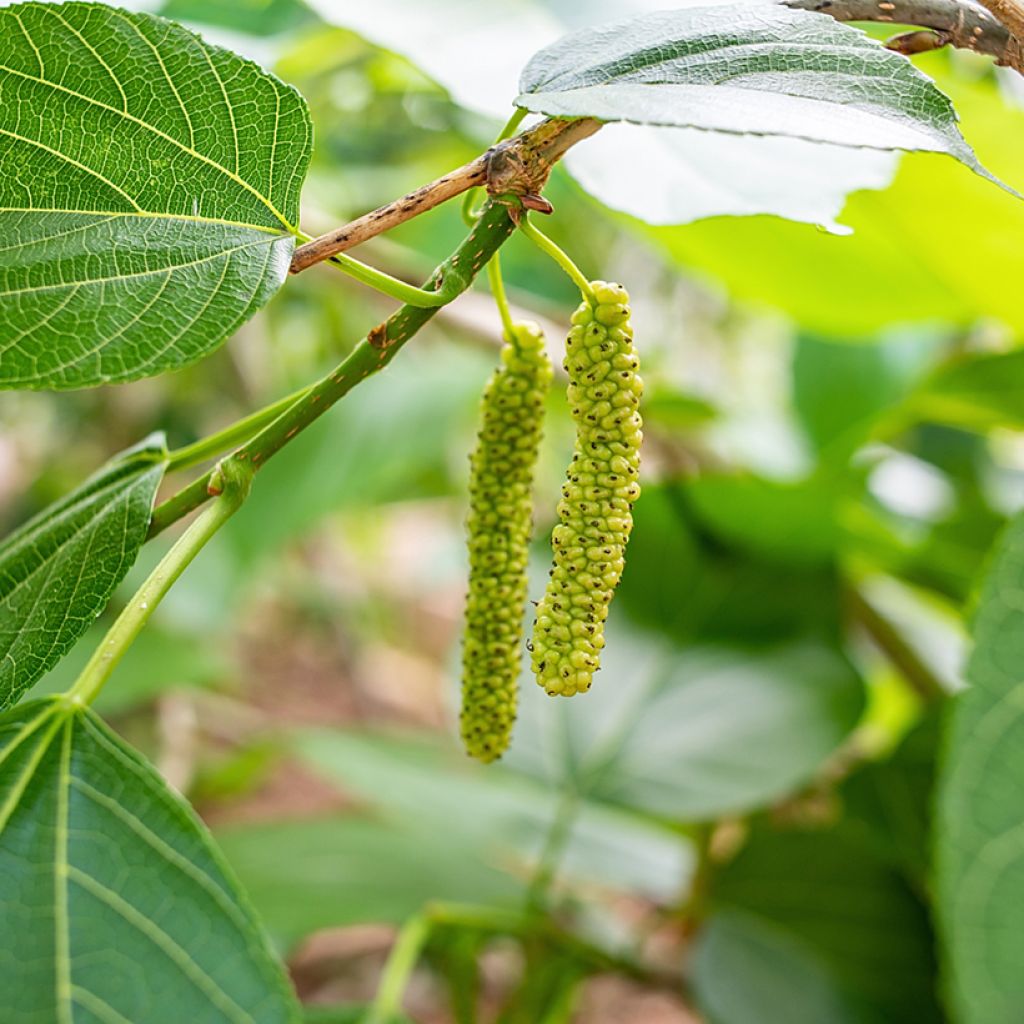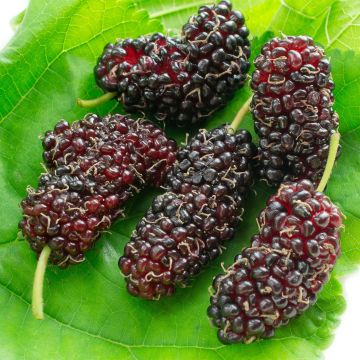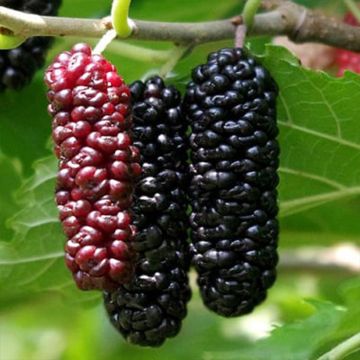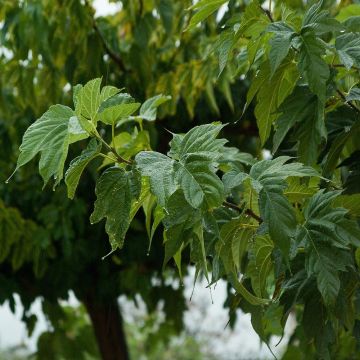

Mûrier blanc King's White - Morus alba var. Laevigata, Morus macroura


Mûrier blanc King's White - Morus alba var. Laevigata, Morus macroura


Mûrier blanc King's White - Morus alba var. Laevigata, Morus macroura


Mûrier blanc King's White - Morus alba var. Laevigata, Morus macroura
Morus alba var. laevigata Kings White - Mullberry
Morus alba var. laevigata King's White
White Mulberry, Common Mulberry
very beautiful specimen vigorous
jean-marc, 06/04/2023
Special offer!
Receive a €20 voucher for any order over €90 (excluding delivery costs, credit notes, and plastic-free options)!
1- Add your favorite plants to your cart.
2- Once you have reached €90, confirm your order (you can even choose the delivery date!).
3- As soon as your order is shipped, you will receive an email containing your voucher code, valid for 3 months (90 days).
Your voucher is unique and can only be used once, for any order with a minimum value of €20, excluding delivery costs.
Can be combined with other current offers, non-divisible and non-refundable.
Why not try an alternative variety in stock?
View all →This plant carries a 24 months recovery warranty
More information
We guarantee the quality of our plants for a full growing cycle, and will replace at our expense any plant that fails to recover under normal climatic and planting conditions.
Would this plant suit my garden?
Set up your Plantfit profile →
Description
Morus alba 'King's White' is a rare cultivar of White Mulberry, valued for its productivity, large-sized pale fruits, and good taste. It is an original fruit tree and also serves as an excellent shade tree due to its dense and luxuriant deciduous foliage, which is light green before turning golden yellow in autumn. Mature specimens often have a hollow, twisted trunk. The fruits are harvested from spring to summer when they become almost white and slightly translucent. They are juicy and sweet, with a hint of honey. Very hardy, and resistant to heat and drought. It has a strong root system and prefers deep, well-drained soils. Its leaves have been used as food for silkworms since time immemorial.
'King's White' belongs to the Moraceae family. Depending on the nomenclature, it is called Morus macroura, Morus alba var. laevigata, or Morus laevigata. This Mulberry is native to the Indian Himalayas and Pakistan but is cultivated elsewhere. In the wild, it can be found up to 1700m (5577ft) in altitude, making it a very cold-resistant species. Like all trees in the Moraceae family, it produces latex in its tissues. The White Mulberry was introduced to France at the end of the 15th century, which led to the development of sericulture.
'King's White' is a tree with a stout appearance, possessing a short and thick trunk topped with a slightly irregular spreading crown if not pruned. It is more commonly seen shaped into a rounded and compact head after pruning. Its growth is rapid during the first few years, then slows down. It can reach 10m (33ft) in all directions. Its bark is light grey and cracks to become thicker, eventually turning grey-brown. The deciduous leaves are polymorphous, meaning their appearance can vary depending on their position on the branches. They measure 6 to 8cm (2 to 3in) in diameter, 10 to 20cm (4 to 8in) in length, and are alternate, petiolate, either simple and cordate or divided into 3 to 7 more or less deep lobes with irregularly toothed margins. The shiny upper surface of the leaf is light green, turning golden yellow in autumn. It develops male or female flowers in different locations on the same tree in March-April. Its insignificant flowering consists of male or female catkins composed of tiny green-yellow flowers. In June-July, the female flowers produce fleshy fruits, measuring up to 10 m (4in) in length. They change colour from green to pale-yellow and nearly white when ripe. They are edible for humans but also highly sought after by birds. The root system of this tree, both taproot and lateral roots, does not tolerate transplanting well. Its strength means it should be planted at a respectable distance from buildings. Its lifespan can reach or even exceed 150 years.
'King's White' thrives in fertile, well-worked, and well-drained soil in a warm and sunny location. It tolerates pollution but dislikes coastal areas and salt spray. Neglected soils benefit from its presence as its leaves gradually enrich the soil each autumn. Traditionally used as a street tree, it can also be planted in a fruit hedge, for example, alongside blackthorns, mirabelle plums, medlars, viburnums, and cornus, to the delight of birds. It can be a beautiful specimen planted alone in the middle of a lawn or near a patio to provide beneficial shade in summer, especially since its fruits do not stain the ground. It is also useful on slopes to combat soil erosion. Its leaves serve as food for silkworms, and it tolerates pruning very well.
The fruits are consumed fresh or cooked. They are much sweeter than the fruits of black mulberry. They are used to make jams and jellies or to garnish pies. They add a touch of sweetness to summer salads and fruit salads. Their flavour pairs well with blackberries (wild blackberry or garden blackberry) and stone fruits such as apricots, plums, and peaches. Those who enjoy sweet and savoury combinations can use them to accompany pork, duck, or game. They also go well with basil, mint, baking spices, rocket, cream, mascarpone, and citrus fruits.
Report an error about the product description
Morus alba var. laevigata Kings White - Mullberry in pictures






Plant habit
Flowering
Foliage
Botanical data
Morus
alba var. laevigata
King's White
Moraceae
White Mulberry, Common Mulberry
China
Other Morus - Mulberry
View all →Planting and care
Plant in full sun in spring or autumn in well-drained, rather fertile and deep soil, that is not too chalky or too acidic. Be careful not to damage its fleshy and brittle roots during planting. It tolerates cold weather perfectly and withstands hot and dry summers once well established. Prune to maintain a beautiful habit. It may be susceptible to rust, hemp or powdery mildew.
Planting period
Intended location
Care
-
, onOrder confirmed
Reply from on Promesse de fleurs
Similar products
Haven't found what you were looking for?
Hardiness is the lowest winter temperature a plant can endure without suffering serious damage or even dying. However, hardiness is affected by location (a sheltered area, such as a patio), protection (winter cover) and soil type (hardiness is improved by well-drained soil).

Photo Sharing Terms & Conditions
In order to encourage gardeners to interact and share their experiences, Promesse de fleurs offers various media enabling content to be uploaded onto its Site - in particular via the ‘Photo sharing’ module.
The User agrees to refrain from:
- Posting any content that is illegal, prejudicial, insulting, racist, inciteful to hatred, revisionist, contrary to public decency, that infringes on privacy or on the privacy rights of third parties, in particular the publicity rights of persons and goods, intellectual property rights, or the right to privacy.
- Submitting content on behalf of a third party;
- Impersonate the identity of a third party and/or publish any personal information about a third party;
In general, the User undertakes to refrain from any unethical behaviour.
All Content (in particular text, comments, files, images, photos, videos, creative works, etc.), which may be subject to property or intellectual property rights, image or other private rights, shall remain the property of the User, subject to the limited rights granted by the terms of the licence granted by Promesse de fleurs as stated below. Users are at liberty to publish or not to publish such Content on the Site, notably via the ‘Photo Sharing’ facility, and accept that this Content shall be made public and freely accessible, notably on the Internet.
Users further acknowledge, undertake to have ,and guarantee that they hold all necessary rights and permissions to publish such material on the Site, in particular with regard to the legislation in force pertaining to any privacy, property, intellectual property, image, or contractual rights, or rights of any other nature. By publishing such Content on the Site, Users acknowledge accepting full liability as publishers of the Content within the meaning of the law, and grant Promesse de fleurs, free of charge, an inclusive, worldwide licence for the said Content for the entire duration of its publication, including all reproduction, representation, up/downloading, displaying, performing, transmission, and storage rights.
Users also grant permission for their name to be linked to the Content and accept that this link may not always be made available.
By engaging in posting material, Users consent to their Content becoming automatically accessible on the Internet, in particular on other sites and/or blogs and/or web pages of the Promesse de fleurs site, including in particular social pages and the Promesse de fleurs catalogue.
Users may secure the removal of entrusted content free of charge by issuing a simple request via our contact form.
The flowering period indicated on our website applies to countries and regions located in USDA zone 8 (France, the United Kingdom, Ireland, the Netherlands, etc.)
It will vary according to where you live:
- In zones 9 to 10 (Italy, Spain, Greece, etc.), flowering will occur about 2 to 4 weeks earlier.
- In zones 6 to 7 (Germany, Poland, Slovenia, and lower mountainous regions), flowering will be delayed by 2 to 3 weeks.
- In zone 5 (Central Europe, Scandinavia), blooming will be delayed by 3 to 5 weeks.
In temperate climates, pruning of spring-flowering shrubs (forsythia, spireas, etc.) should be done just after flowering.
Pruning of summer-flowering shrubs (Indian Lilac, Perovskia, etc.) can be done in winter or spring.
In cold regions as well as with frost-sensitive plants, avoid pruning too early when severe frosts may still occur.
The planting period indicated on our website applies to countries and regions located in USDA zone 8 (France, United Kingdom, Ireland, Netherlands).
It will vary according to where you live:
- In Mediterranean zones (Marseille, Madrid, Milan, etc.), autumn and winter are the best planting periods.
- In continental zones (Strasbourg, Munich, Vienna, etc.), delay planting by 2 to 3 weeks in spring and bring it forward by 2 to 4 weeks in autumn.
- In mountainous regions (the Alps, Pyrenees, Carpathians, etc.), it is best to plant in late spring (May-June) or late summer (August-September).
The harvesting period indicated on our website applies to countries and regions in USDA zone 8 (France, England, Ireland, the Netherlands).
In colder areas (Scandinavia, Poland, Austria...) fruit and vegetable harvests are likely to be delayed by 3-4 weeks.
In warmer areas (Italy, Spain, Greece, etc.), harvesting will probably take place earlier, depending on weather conditions.
The sowing periods indicated on our website apply to countries and regions within USDA Zone 8 (France, UK, Ireland, Netherlands).
In colder areas (Scandinavia, Poland, Austria...), delay any outdoor sowing by 3-4 weeks, or sow under glass.
In warmer climes (Italy, Spain, Greece, etc.), bring outdoor sowing forward by a few weeks.




















































